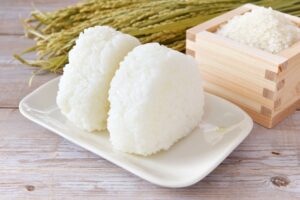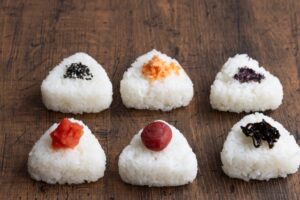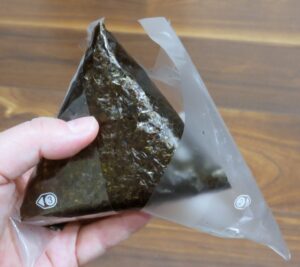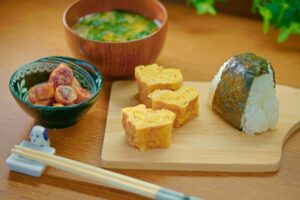History of onigiri

Onigiri is a simple yet deeply meaningful dish representative of Japanese food culture. They are widely loved for their shape, ingredients, and ease of eating. Onigiri is not only a meal, but also a dish filled with cultural background and history, which can be further understood by tracing its roots. This article details the history of onigiri, its development, and its importance in the Japanese diet.
1 Origins of Onigiri

There are many theories about the origin of onigiri, but the most popular theory is that it dates back to the “nigiri-meshi” or “salted rice ball” of ancient Japan. Records of “nigiri-han” eaten by ancient Japanese can be found in history books such as the Chronicles of Japan. The first rice balls were simple, just rice seasoned with salt and hand-rolled, without the addition of ingredients as we know them today.

It is said that onigiri first appeared around the Heian period (794 – 1185), and was valued as a convenient preserved food to eat between farm work or on a journey, and as an easily portable meal. During this period, onigiri were also called “omusubi” (rice balls) and were also considered a food with sacred connotations.
2 Development and Types of Onigiri

In the Edo period (1603 – 1868), onigiri became increasingly popular among the common people as a convenient and nutritious meal for traders and long-distance travelers. During this period, onigiri evolved further and began to include more ingredients. For example, it became common to include ingredients such as salmon, kelp, and pickled plums, each of which symbolized a particular region or season.
In addition, during the Edo period (1603-1867), “onigiriya” (onigiri shops) appeared, making onigiri easily available for purchase while out and about, further positioning onigiri as an everyday food. As a result, onigiri became not only a preserved food, but also an indispensable light meal for the common people.
3 Modern Onigiri and its Popularity

Today’s onigiri is easily available at convenience stores and supermarkets, making it a very convenient food in our busy daily lives. In Japan, onigiri can be easily prepared at home, making them a favorite breakfast and bento box staple. Ingredients have also diversified, and in addition to the traditional salmon and pickled plum, many other flavors have appeared, such as tuna mayo, curry flavor, and nori rolls, reflecting the diversification of food culture.
In addition, onigiri is attracting attention not only in Japan but also around the world. Partly due to the Japanese food boom, onigiri are now offered in Japanese restaurants abroad and are accepted in different cultures. Recently, onigiri are also gaining popularity among health-conscious people because of their low calorie content and high nutritional value.
4 Cultural and Social Background of Onigiri

Onigiri is more than just a meal; it has a meaning deeply rooted in Japanese culture. Its shape has long been a special food for the Japanese, as evidenced by the fact that onigiri are called “omusubi” with a sacred meaning. It is also sometimes used as an offering for celebrations, festivals, and festivals, and onigiri is imbued with the heart and spirit of the Japanese people.


Furthermore, onigiri is widely recognized as a food that symbolizes “family ties. For example, onigiri made by mothers are very important to Japanese families as a reminder of family affection and caring. In addition, taking onigiri on picnics or eating onigiri when traveling creates moments of bonding with family and friends.
5 The Healthy Appeal and Future of Onigiri

Onigiri is also gaining attention as a healthy and nutritious food. In particular, onigiri made with brown rice, cereal grains, or other low-calorie, healthy ingredients are gaining popularity, making them ideal for health-conscious people. The convenience and nutritional value of onigiri have made them an important option for today’s busy people to have a quick and healthy meal.
In addition, onigiri will continue to evolve and open up new possibilities in a variety of forms. In an increasingly globalized world, onigiri, a representative of Japanese food culture, has the potential to spread internationally as people around the world discover its new appeal.
Conclusion

Onigiri is a heartwarming dish that reflects the simple yet profound Japanese food culture. It is hoped that in the future, onigiri will continue to be loved by people around the world as its appeal is passed on to new generations.
